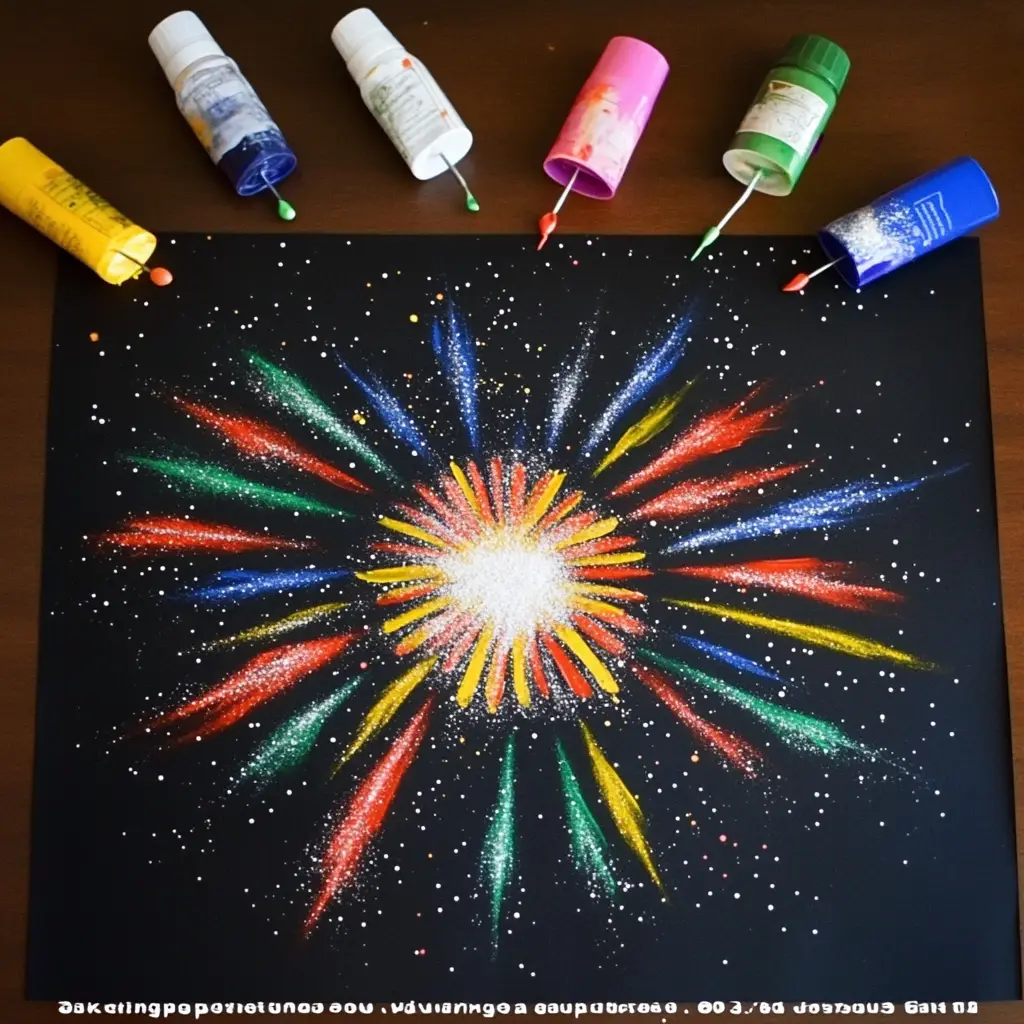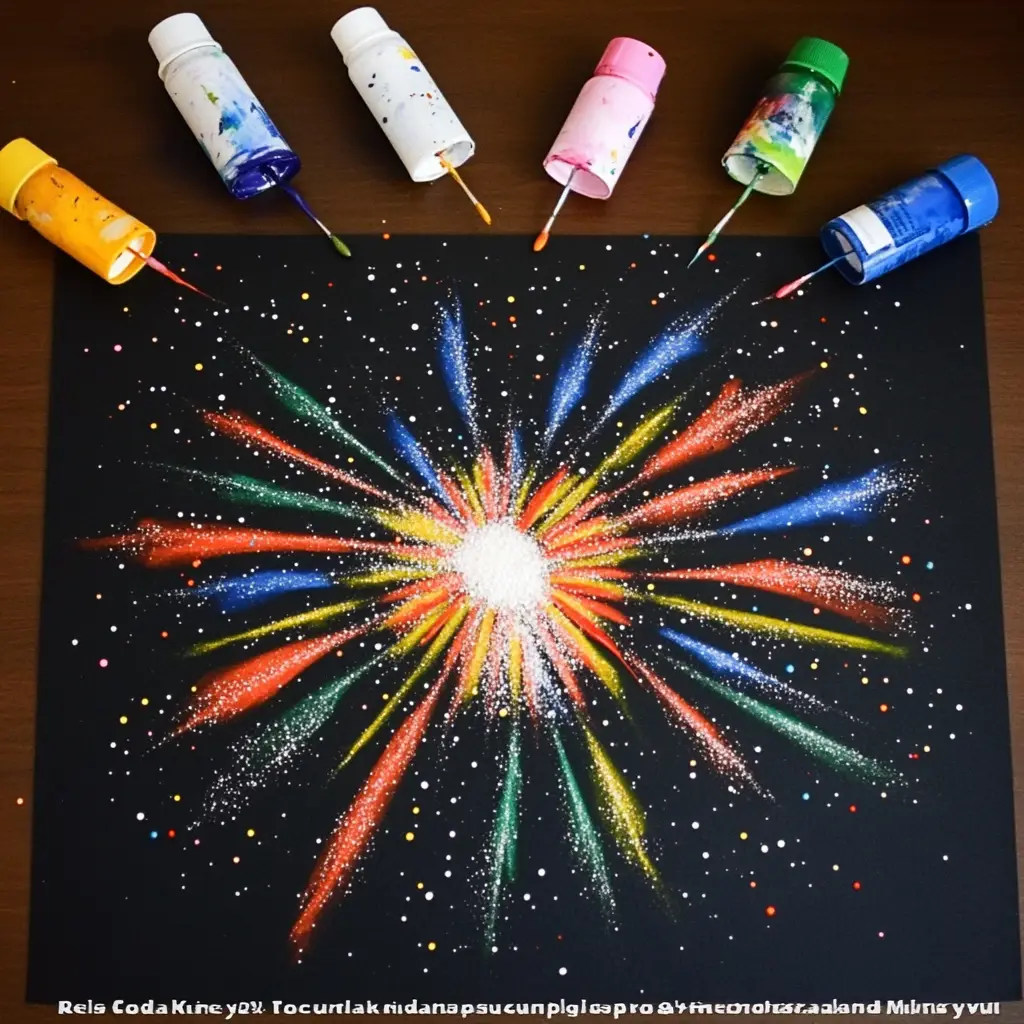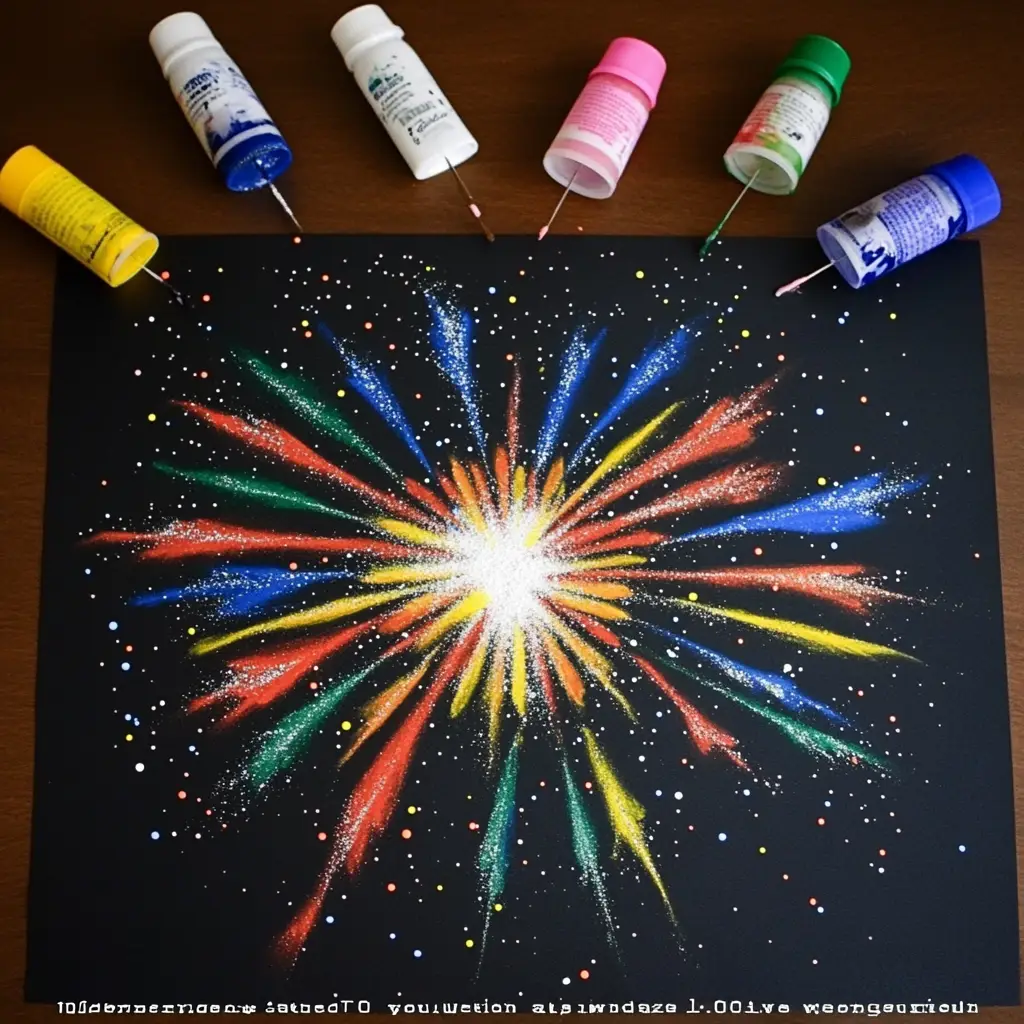Salt & Glue Fireworks Painting is a visually stunning, sensory-rich craft project that combines creativity with basic science in a fun, engaging way. Designed for children, families, and educators, this activity mimics dazzling firework explosions using simple materials like glue, salt, and color. It’s especially popular around celebratory holidays such as the Fourth of July, New Year’s Eve, or birthdays, but its appeal lasts year-round due to its mesmerizing visual effects and tactile nature.
Whether you’re looking to add an exciting art project to your summer camp curriculum, homeschool routine, or family weekend plans, this painting activity offers an unbeatable combination of low-cost supplies, visual impact, and STEAM learning.
Why is the Salt & Glue Fireworks Painting so popular?
1. Visually Stunning Results with Minimal Effort
One of the biggest reasons for its popularity is the wow factor it delivers. The moment children (or adults!) touch the brush or pipette to the salted glue, the color instantly travels along the lines, creating glowing, almost magical bursts of color. The vibrant fireworks against a dark background look professional and dazzling, even if made by young kids with no artistic training.
2. Incredibly Easy to Set Up and Do
You only need a few everyday materials — glue, salt, black paper, and food coloring or watercolors. There’s no need for fancy art supplies or complicated instructions. It’s beginner-friendly, making it ideal for parents, teachers, and caregivers who want something fun, creative, and low-prep.
3. Combines Art and Science (STEAM)
This craft isn’t just pretty — it also introduces basic science concepts like:
-
Capillary action (how the color moves through the salt)
-
Absorption and diffusion
-
Color mixing and visual blending
This makes it a perfect STEAM activity, blending creative expression with hands-on learning — something educators love to include in both formal and informal teaching settings.
4. Loved by All Ages
From preschoolers to tweens (and even adults!), any age group can enjoy this activity. Younger kids are fascinated by the sensory aspect, while older kids enjoy perfecting their designs and experimenting with color. This wide age appeal makes it popular for classrooms, summer camps, family nights, and even art therapy.
5. Perfect for Holidays and Celebrations
Salt & Glue Fireworks Painting is especially popular around:
-
Independence Day (4th of July)
-
New Year’s Eve
-
Birthdays
-
Summer celebrations
It’s a craft that captures the festive feeling of fireworks without any danger or noise — making it ideal for indoor fun and kid-safe holiday activities.
6. Supports Motor and Sensory Development
The activity helps kids strengthen:
-
Fine motor skills (from squeezing glue and painting)
-
Hand-eye coordination
-
Sensory processing (through texture, movement, and color)
Parents and occupational therapists alike love it as a way to encourage development through play.
7. Pinterest-Perfect and Highly Shareable
In today’s digital world, visual crafts that look great on camera spread fast on Pinterest, Instagram, and TikTok. Salt & Glue Fireworks Painting checks all the boxes:
-
Bright, colorful visuals
-
Easy step-by-step process
-
Eye-catching before-and-after transformations
This viral potential keeps it trending each year during peak craft seasons.
8. Customizable and Expandable
There are endless ways to adapt this craft:
-
Add glitter, metallics, or glow-in-the-dark paint
-
Turn it into a collage or classroom mural
-
Use it to teach constellations, planets, or nighttime scenes
-
Pair it with a storytime or science lesson
Its flexibility makes it more than just a one-time craft — it becomes a reusable tool for creativity and teaching.
In Summary:
Salt & Glue Fireworks Painting is so popular because it’s fun, beautiful, easy to do, educational, and endlessly customizable. It brings together art and science in a way that kids love and adults appreciate. Whether for a holiday celebration, summer boredom buster, or classroom project, it consistently delivers excitement, learning, and gorgeous results.

Why You’ll Love This Project
It’s Simple and Budget-Friendly
All the materials required are easily found at home or in classrooms—no expensive art tools or specialty items needed. It’s ideal for parents and teachers working within a budget.
Encourages Creative Expression
Every firework design is unique. Kids can mix colors, layer designs, and experiment freely, boosting confidence and artistic exploration.
Teaches Science Through Art
This project introduces capillary action, color diffusion, and absorption in an exciting, hands-on way. Kids learn scientific principles while watching colors magically travel through salt lines.
Great for All Ages
Whether you’re working with preschoolers, elementary students, or tweens, this activity can be tailored to suit any developmental level and artistic ability.
Sensory and Motor Skills Development
Using glue bottles, sprinkling salt, and carefully applying color with pipettes or brushes enhances fine motor coordination and sensory processing.
Materials and Ingredients
Before starting, make sure you have all the materials on hand. This list is for four paintings, but quantities can be scaled up or down.
You’ll Need:
-
4 sheets of black construction paper (9 × 12 in recommended)
-
1 cup of white school glue (in a squeeze bottle)
-
1 cup of fine table salt
-
½ cup of liquid watercolors or diluted food coloring (mixed 1:1 with water)
-
4 small paintbrushes or pipettes (one per color)
-
1 tsp of edible glitter or silver luster dust (optional for sparkle)
-
1 plastic tray or rimmed baking sheet (to catch extra salt)
-
Paper towels and smocks or aprons (to keep cleanup easy)
Pro Tip: Use black or dark paper to mimic the night sky—this makes the vibrant colors pop even more.

Step-by-Step Preparation
Follow these steps to create dazzling fireworks that seem to burst off the page.
Step 1: Set Up Your Work Area
Cover your table with old newspaper or a plastic tablecloth. Place a piece of construction paper on a rimmed tray or baking sheet to catch excess salt. Have paper towels and smocks ready.
Step 2: Draw Fireworks with Glue
Use the glue bottle to draw radiating lines, bursts, or spiral patterns representing fireworks. Keep the glue lines thick so they can hold a lot of salt and color.
Creative Tip: Draw multiple firework bursts on the same page to create a full “sky” of exploding color.
Step 3: Sprinkle Salt
Quickly cover all wet glue lines with a generous amount of salt. Use your fingers or a spoon to make sure it coats every line thoroughly.
Tilt the tray gently to shake off the excess salt. Save the leftover salt for reuse.
Step 4: Add Sparkle (Optional)
While the salt is still slightly damp, sprinkle a pinch of edible glitter or luster dust over the lines. This will give your fireworks a metallic, shimmering glow when finished.
Step 5: Apply Color
Dip your brush or pipette into the liquid watercolor. Gently touch the salted line—don’t brush! The color will naturally wick through the salt, creating a glowing, magical effect.
Repeat with different colors for a vibrant, multi-colored firework display.
Avoid flooding the salt with too much liquid, as it can cause smudging or glue breakdown.
Step 6: Let It Dry
Lay your painting flat in a safe space and let it dry completely. This usually takes 3–4 hours. After drying, gently tap the paper to remove loose salt.
Variations and Creative Enhancements
There are countless ways to adapt or expand this project for even more fun and learning:
Change the Background
Use navy, dark purple, or galaxy-painted paper for different nighttime skies. Add pre-painted stars, moons, or constellations in the background for extra flair.
Use Metallic Paints
Metallic or neon watercolors give a bold, glowing effect and add extra drama to your fireworks.
Try Themed Templates
For younger kids, use firework stencils or cookie cutters to trace shapes in glue. This keeps designs uniform and easy.
Add Other Textures
Sprinkle sequins, colored sand, or crushed chalk over the salt for added texture and a mixed-media look.
Interactive Group Projects
Use a large poster board and let multiple kids contribute their own fireworks to one collaborative sky—perfect for classrooms or group activities.
Educational Benefits
This craft is more than just fun—it’s packed with developmental and educational value.
Capillary Action in Action
The color travels through the salt lines using capillary action, a natural scientific process where liquid moves through porous materials.
Color Theory Exploration
Mixing and blending primary and secondary colors gives kids hands-on lessons in color theory.
Sensory Development
Handling glue, salt, and watery paint introduces varied textures, helping to stimulate young sensory systems.
Fine Motor Skill Practice
Squeezing glue bottles, sprinkling salt, and guiding tiny brushes all support hand-eye coordination and early writing readiness.
Creative Confidence
Kids love seeing their efforts transform into colorful explosions. It fosters a sense of pride, imagination, and artistic identity.
Cleanup Tips
While relatively low-mess, a little prep can make post-craft cleanup fast and easy:
-
Use trays to catch salt and glue drips
-
Keep a wet towel or wipes nearby
-
Wash brushes immediately to avoid staining
-
Shake dry salt off paintings outside or over a trash can
-
Store art flat to prevent salt flaking or bending
Project Timing
| Activity | Time |
|---|---|
| Workspace setup | 10 minutes |
| Drawing & salting | 10 minutes |
| Coloring & blending | 20–30 minutes |
| Drying time | 3–4 hours |
| Total project time | ~4.5 hours |
Nutritional Information
While this isn’t an edible recipe, if you’re using edible glitter, ensure children do not consume the final product. All other materials are non-toxic, but should still be handled with care, especially around younger children.
Frequently Asked Questions
Can I use coarse salt instead of fine salt?
You can, but fine-grain salt works best for smooth wicking and clean lines. Coarse salt may result in blotchy or slower color absorption.
Is food coloring better than watercolors?
Both work well. Liquid watercolors tend to be more vibrant and easier to control, but diluted food coloring is a great low-cost option.
Will the artwork last over time?
Yes, but over time, salt may flake. To preserve it, consider laminating the piece or spraying lightly with a clear fixative once fully dry.
Is this project suitable for toddlers?
Yes, with supervision. Avoid allowing toddlers to handle glitter unsupervised, and always monitor glue and paint use to prevent ingestion.
Can I make this a classroom project?
Absolutely. It’s ideal for classrooms. Set up in stations (glue, salt, paint, dry area) and work in small groups to keep things orderly.
Conclusion
Salt & Glue Fireworks Painting is more than just a pretty picture—it’s an enriching, joyful, and visually captivating experience for children of all ages. From designing unique fireworks to watching color spread magically through salt, kids are enchanted by every step of the process.
As a bonus, this craft sneaks in STEM learning, fine motor development, and sensory exploration, making it an excellent choice for teachers, parents, and caretakers alike. With endless customization options and simple materials, it’s a project you’ll return to again and again for holidays, seasonal activities, or rainy-day fun.
So grab your glue, pour your salt, and let creativity explode like fireworks in the night sky.


